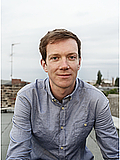Experimental investigation of flow fields in the interstices of bulk particles with ray tracing based reconstruction
Projektleiter:
Jun.-Prof. Dr. Christian Lessig , Dr.-Ing. Katharina Zähringer
Projektbearbeiter:
Mirko Ebert
Finanzierung:
The flow behaviour of the gas phase in a packed bed has important effects on mass and energy transport processes that are taking place in the bed. It is hence also a central parameter for process optimisation of such systems. Currently, however, only very limited data on the gas flow in packed beds exists, since the access to the particle interstices is very challenging with both probe-based and optical measurement methods. Furthermore, the existing results were typically obtained using refractive index matching, and are hence limited to liquids. For gaseous flows, mainly conclusions obtained using similarity theory are available, which limits the potential range of application.
In this project, we extend optical particle image velocimetry (PIV) of the velocity fields in the gas phase within packed beds by ray tracing reconstructions. For this, we use beds consisting of transparent bulk material so that the velocity field determination can be aided with a numerical simulation of light propagation through the bed. The simulation is performed with ray tracing, and the resulting information is used to correct the raw PIV particle images of the flow. This technique then allows for the direct measurement of velocity fields in the gas phase of transparent packed beds. For the development of the reconstruction method, the packed bed is modelled using transparent spherical packing material in regular arrangements. The high sensitivity of the method to a precise correspondence between the experimental set-up and the simulation, including, for example, the exact shape and refractive indices of the spheres, will be addressed systematically through the numerical optimisation of the parameters used in the simulation as well as new methods for PIV illumination, calibration and post-processing. The gas flow in the bed will be varied concerning Reynolds number, arrangement of the gas inlets to the bed, and packing material size and arrangement. High-speed PIV will give access not only to the mean velocities but also to fluctuations and turbulence quantities in the interstices. These are important for heat and mass transfer modelling. The velocity fields obtained with the new technique are validated with results of endoscopic measurements, with the mean velocity fields measured in the partner project A2, the simulated velocities from A4 and C6, and, at the bed surface, by comparison with the velocity fields measured by standard PIV directly above the bed. The project will also deliver a complete methodology, including a ray tracing software, that facilitates the adoption of the method by the scientific community. The ray tracing expertise and software of the present project will also be used in a cross-site collaboration with project B3 in Bochum to characterise the radiation experiment performed there.
In this project, we extend optical particle image velocimetry (PIV) of the velocity fields in the gas phase within packed beds by ray tracing reconstructions. For this, we use beds consisting of transparent bulk material so that the velocity field determination can be aided with a numerical simulation of light propagation through the bed. The simulation is performed with ray tracing, and the resulting information is used to correct the raw PIV particle images of the flow. This technique then allows for the direct measurement of velocity fields in the gas phase of transparent packed beds. For the development of the reconstruction method, the packed bed is modelled using transparent spherical packing material in regular arrangements. The high sensitivity of the method to a precise correspondence between the experimental set-up and the simulation, including, for example, the exact shape and refractive indices of the spheres, will be addressed systematically through the numerical optimisation of the parameters used in the simulation as well as new methods for PIV illumination, calibration and post-processing. The gas flow in the bed will be varied concerning Reynolds number, arrangement of the gas inlets to the bed, and packing material size and arrangement. High-speed PIV will give access not only to the mean velocities but also to fluctuations and turbulence quantities in the interstices. These are important for heat and mass transfer modelling. The velocity fields obtained with the new technique are validated with results of endoscopic measurements, with the mean velocity fields measured in the partner project A2, the simulated velocities from A4 and C6, and, at the bed surface, by comparison with the velocity fields measured by standard PIV directly above the bed. The project will also deliver a complete methodology, including a ray tracing software, that facilitates the adoption of the method by the scientific community. The ray tracing expertise and software of the present project will also be used in a cross-site collaboration with project B3 in Bochum to characterise the radiation experiment performed there.
Kooperationen im Projekt
Kontakt

Jun.-Prof. Dr. Christian Lessig
Otto-von-Guericke-Universität Magdeburg
Institut für Simulation und Graphik
Universitätsplatz 2
39116
Magdeburg
Tel.:+49 391 6752922
weitere Projekte
Die Daten werden geladen ...


